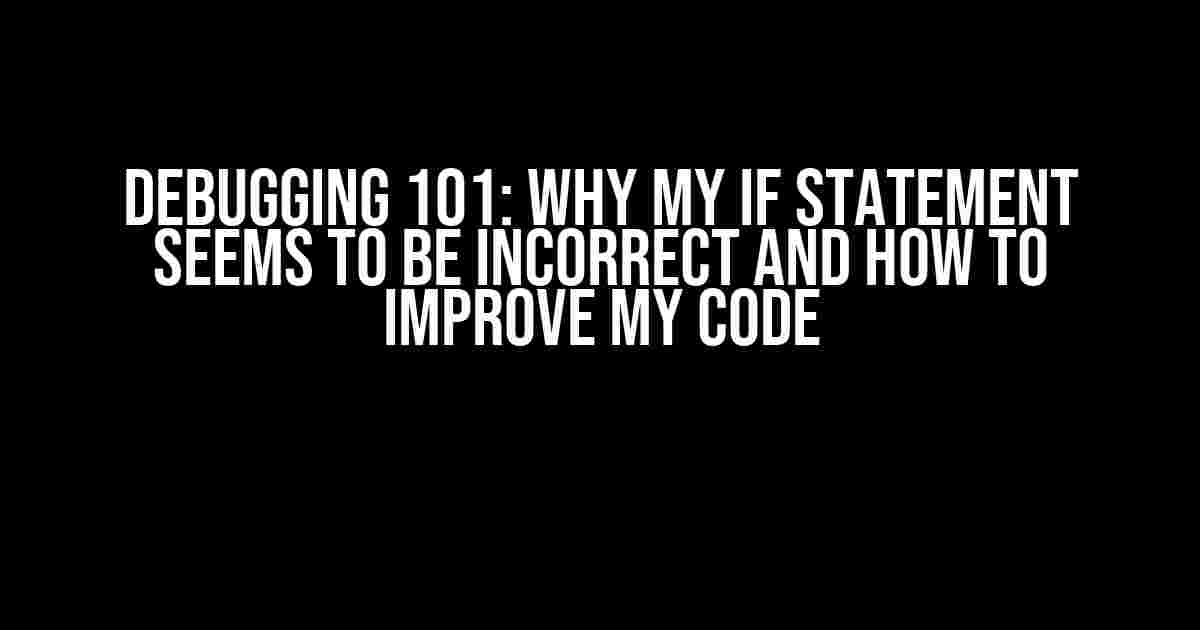Are you pulling your hair out trying to figure out why your if statement isn’t working as expected? You’re not alone! In this article, we’ll dive into the most common mistakes that can lead to an incorrect if statement, and provide you with actionable tips to improve your code.
Understanding the Basics: How If Statements Work
if (condition) {
// code to be executed if condition is true
} else {
// code to be executed if condition is false
}
The condition is evaluated, and if it’s true, the code inside the if block is executed. If the condition is false, the code inside the else block is executed (if present).
Common Mistakes Leading to Incorrect If Statements
Now that we’ve covered the basics, let’s explore the most common mistakes that can lead to an incorrect if statement:
-
Syntax Errors
A single misplaced character or incorrect syntax can lead to an incorrect if statement. Make sure to check your code for any syntax errors, such as missing brackets, incorrect indentation, or mismatched quotes.
-
Logical Errors
A logical error occurs when the condition is not properly evaluating to true or false. This can happen when you’re using the wrong operator (e.g., using = instead of ==), or when you’re not considering all possible scenarios.
-
Variable Scope and Hoisting
Variable scope and hoisting can affect the behavior of your if statement. Ensure that you understand how variable scope works in your programming language, and avoid declaring variables inside the if statement block.
-
Type Coercion and Conversion
Type coercion and conversion can lead to unexpected results in your if statement. Be mindful of the data types you’re working with, and ensure that you’re not accidentally converting a value to a different type.
Troubleshooting Steps to Improve Your If Statement
Now that we’ve covered the common mistakes, let’s walk through a step-by-step process to troubleshoot and improve your if statement:
-
Check the Condition
Print or log the condition to ensure it’s evaluating to the expected value. This can help you identify any logical errors or syntax mistakes.
-
Use a Debugger
Use a debugger to step through your code and examine the values of variables at each step. This can help you identify any unexpected behavior or logical errors.
-
Simplify the Condition
Break down the condition into smaller, more manageable parts. This can help you identify any syntax mistakes or logical errors.
-
Test Edge Cases
Test your if statement with edge cases to ensure it’s working correctly. This can include testing with extreme values, null or undefined values, or unexpected input.
-
Consult the Documentation
Consult the documentation for your programming language or framework to ensure you’re using the correct syntax and operators.
Best Practices for Writing If Statements
To avoid common mistakes and write more effective if statements, follow these best practices:
| Best Practice | Description |
|---|---|
| Use meaningful variable names | Use descriptive variable names to improve code readability and reduce errors. |
| Keep conditions simple | Avoid complex conditions by breaking them down into smaller, more manageable parts. |
| Use consistent syntax | Use consistent syntax throughout your code to reduce errors and improve readability. |
| Test thoroughly | Test your if statement with various inputs and edge cases to ensure it’s working correctly. |
Conclusion
Writing an effective if statement requires attention to detail, a solid understanding of programming fundamentals, and a willingness to test and debug your code. By following the troubleshooting steps and best practices outlined in this article, you can improve your code and avoid common mistakes that can lead to an incorrect if statement. Remember, debugging is an essential part of the programming process, and with practice and patience, you can become a master of writing correct and efficient if statements.
So, the next time you’re struggling with an if statement, don’t panic! Take a deep breath, follow the steps outlined in this article, and remember that with persistence and practice, you can overcome any coding challenge.
Frequently Asked Question
Got a pesky if statement that just won’t cooperate? Don’t worry, we’ve all been there! Here are some common issues and their solutions to get your code back on track.
What’s the most common mistake people make with if statements?
One of the most common mistakes is using a single equals sign (=) for assignment instead of a double equals sign (==) for comparison. This can lead to unexpected behavior and logical errors. Make sure to use the correct operator for your needs!
How can I avoid using too many nested if statements?
One way to avoid nesting hell is to use early returns or continue statements to simplify your logic. You can also consider using switch statements or refactoring your code to make it more modular and easier to read.
What’s the difference between && and || operators in if statements?
The && operator is a logical AND operator, which means both conditions must be true for the statement to execute. The || operator is a logical OR operator, which means at least one condition must be true for the statement to execute. Choose the operator that best fits your logic!
How can I debug my if statement to see what’s going wrong?
Use console logs or a debugger to examine the values of your variables and see how they’re being evaluated. You can also try simplifying your condition or breaking it down into smaller parts to isolate the issue.
What’s a good way to make my if statements more readable?
Use descriptive variable names and consider breaking down long conditions into smaller, more readable pieces. You can also use parentheses to group conditions and make them easier to understand.
